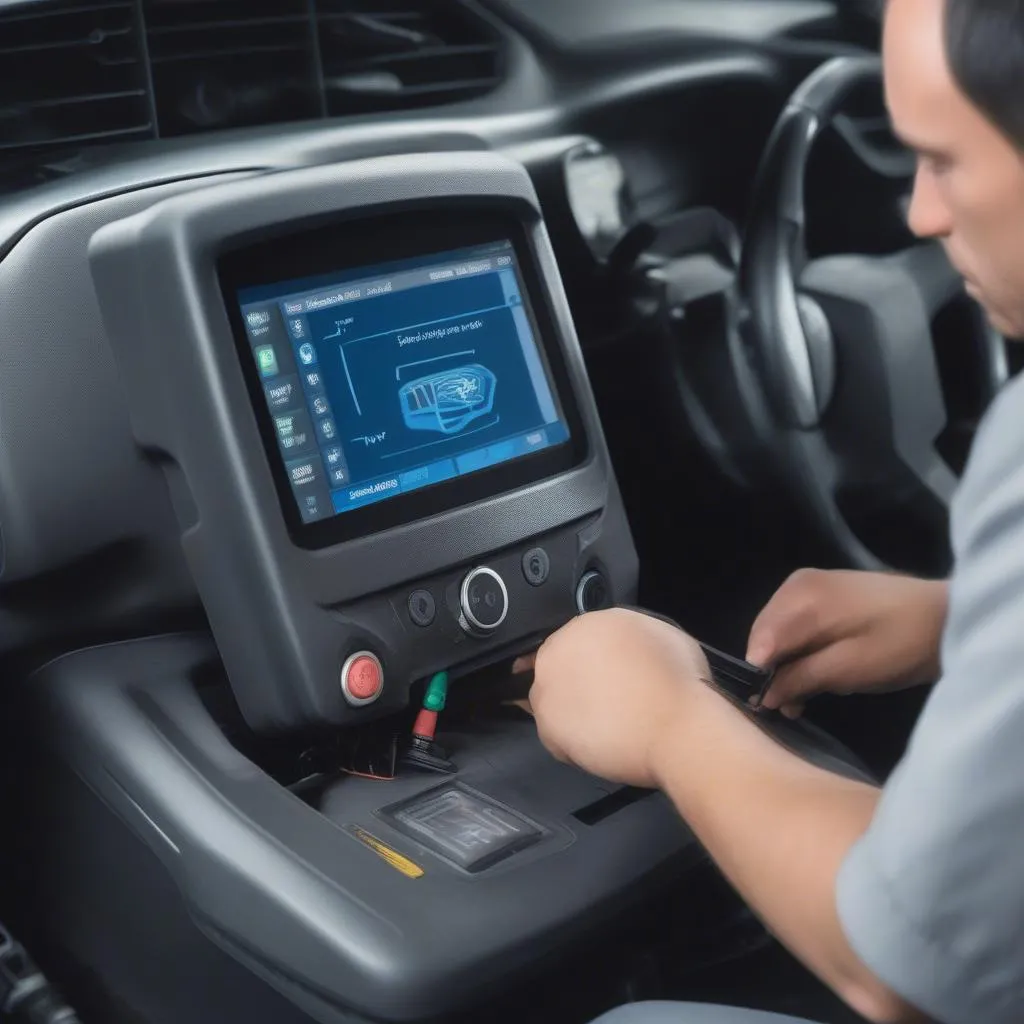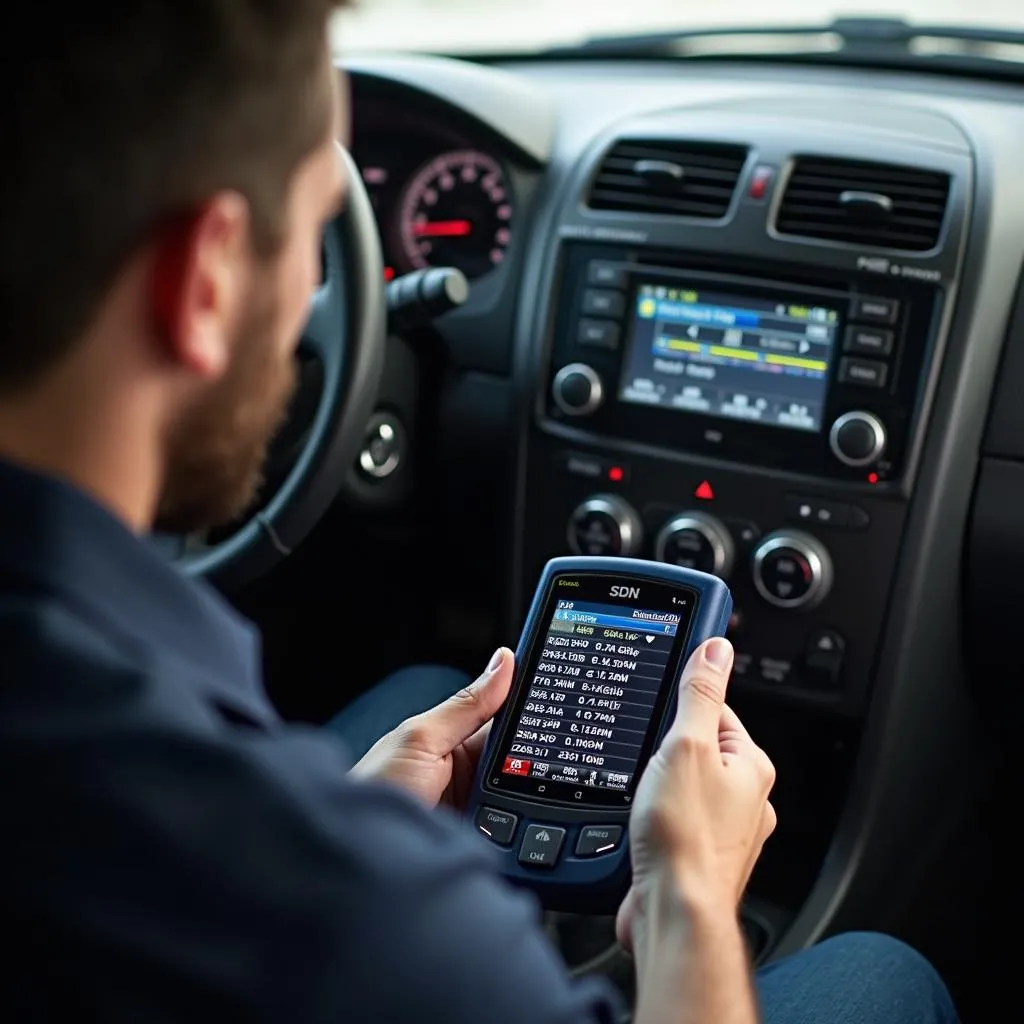The brake warning light on your dashboard is an essential safety feature that alerts you to potential problems with your vehicle’s braking system. If this light illuminates, it’s crucial not to ignore it. A glowing brake warning light could signal anything from a simple issue like low brake fluid to a more serious problem requiring immediate attention.
Understanding Your Car’s Brake Warning Light
While the exact appearance might vary slightly between car manufacturers, the brake warning light is typically a bright, attention-grabbing red or orange symbol on your dashboard. It often takes the form of an exclamation point (!) surrounded by a circle or parentheses, resembling this: ( ! ). In some vehicles, the word “BRAKE” might also illuminate alongside the symbol.
Common Reasons Your Brake Warning Light is On
There are several reasons why your brake warning light might be on. Let’s break down the most common culprits:
-
Low Brake Fluid: This is one of the most frequent reasons for the brake warning light to turn on. Brake fluid is essential for transmitting the force from your foot on the brake pedal to the brake calipers that stop the wheels. If there’s a leak in the brake lines, the fluid level drops, triggering the warning light.
-
Worn Brake Pads: Brake pads are designed to wear down over time. When they become too thin, a sensor inside the pad triggers the brake warning light. Driving with worn brake pads not only reduces your braking efficiency but can also damage the brake rotors, leading to costly repairs.
-
Faulty Brake Sensor: The brake pad wear sensors themselves can sometimes malfunction. A faulty sensor might send a false signal to the dashboard, causing the brake warning light to illuminate even if the brake pads are in good condition.
-
Parking Brake Engaged: In many vehicles, the brake warning light will also come on if the parking brake is engaged, even partially. This serves as a reminder to release the parking brake before driving.
-
Issues with the ABS System: The Anti-lock Braking System (ABS) is crucial for preventing wheel lockup during hard braking. If there’s a problem with the ABS system, a separate warning light might come on. However, in some cars, the brake warning light may also illuminate if the ABS system detects a fault.
-
Master Cylinder Problems: The master cylinder is a critical component of the braking system responsible for distributing brake fluid to all four wheels. A malfunctioning master cylinder can lead to a loss of braking pressure and trigger the warning light.
What to Do When the Brake Warning Light Comes On
If your brake warning light comes on, it’s crucial to take action immediately:
-
Safely Pull Over: Find a safe location to pull over as soon as possible. Avoid heavy traffic areas and if you’re on a highway, try to get to the shoulder or an exit ramp.
-
Check Your Parking Brake: Before panicking, make sure the parking brake is fully disengaged. If it’s even slightly on, it can trigger the warning light.
-
Check Your Brake Fluid Level: If it’s safe to do so, carefully open the hood and locate the brake fluid reservoir. Consult your owner’s manual for its exact location. Check the fluid level. If it’s below the “MIN” line, you’ll need to add more brake fluid.
CAUTION: Do not drive your car if the brake fluid level is significantly low. Driving with low or no brake fluid can result in complete brake failure, putting you and others at risk.
- Contact a Mechanic: If the brake fluid level is fine, the parking brake is disengaged, and the warning light persists, it’s best to err on the side of caution and contact a qualified mechanic as soon as possible. A mechanic can properly diagnose the issue and perform any necessary repairs.
Brake Warning Light vs. ABS Light
It’s important to differentiate between the brake warning light and the ABS warning light, as they indicate different issues. The ABS light, usually yellow or amber, specifically signals a problem with the Anti-lock Braking System. While a faulty ABS system doesn’t mean your brakes have completely failed, it does mean you won’t have the added safety of anti-lock brakes in an emergency situation.
Remote Diagnostics and Software Solutions
In some cases, modern vehicles equipped with advanced technology may allow for remote diagnostics and software-based solutions. For example, if a faulty sensor is triggering the brake warning light, a remote software update might be possible, saving you a trip to the mechanic.
To explore remote diagnostic and software options for your vehicle, you can visit websites like:
- 2011 hyundai elantra brake warning light
- nissan nv200 brake warning light
- 2012 ford focus brake warning light
“Remote diagnostics have revolutionized the way we approach car repairs,” says automotive expert, Emily Carter. “In many instances, we can now pinpoint the issue and even implement software fixes remotely, saving car owners valuable time and money.”
Never Ignore the Brake Warning Light
The brake warning light is your car’s way of telling you something is wrong with one of its most critical safety systems. Ignoring it can have serious consequences.
“Addressing brake issues promptly not only ensures your safety but can also save you from costly repairs down the line,” advises Michael Chen, Senior Mechanic at AutoSafe Solutions.
By understanding the potential causes of a brake warning light and taking appropriate action, you can maintain your car’s safety and enjoy peace of mind on the road.


